Mad Max: Fury Road wasn’t just a film; it was a high-octane sensory assault. Beyond the breathtaking stunts and visceral action, a single image seared itself into the collective consciousness: the Doof Warrior, suspended on a monstrous vehicle, shredding a flame-throwing double-neck guitar. This wasn’t just a prop; it was the Guitar Fury Road, a character in its own right, amplifying the film’s chaotic energy and becoming an instant icon. More than just a visually striking instrument, the guitar fury road embodies the film’s spirit of twisted ingenuity and over-the-top spectacle, resonating with both moviegoers and guitar enthusiasts alike.
The Genesis of the Fury Road Guitar: From Concept to Reality
The seeds of the guitar fury road were sown long before the cameras rolled on the Namibian desert. Visionary director George Miller, the mastermind behind the Mad Max franchise, conceived the Doof Warrior and his sonic weapon as integral parts of the film’s狂野 (wild) world. Early concept art, meticulously crafted by Australian storyboard artist Peter Pound in the late 1990s, already featured the狂人 (madman) musician and his speaker-laden truck, the Doof Wagon. Miller’s direction to his team was clear: the guitar had to be a “sick weapon,” a visual and auditory embodiment of the film’s relentless intensity. To bring this狂想 (fantasy) to life, Miller sought out artists who could transform discarded objects into breathtaking creations. This led him to Michael Ulman, a Boston-based sculptor with a penchant for turning trash into treasure.
 Michael Ulman with director George Miller
Michael Ulman with director George Miller
Michael Ulman and George Miller collaborating on the Mad Max Fury Road guitar design.
Michael Ulman’s Vision: Scavenging for Sonic Mayhem
Michael Ulman wasn’t a traditional luthier; he was a found-object artist, a scavenger of sonic mayhem. His portfolio was filled with intricate models of vehicles crafted from discarded radios, kitchen appliances, and anything else he could find. His “speed shit” aesthetic, as he calls it, was a perfect match for the狂暴 (furious) world of Mad Max. Miller recognized this kindred spirit and invited Ulman to Australia with a simple brief: create the guitar fury road. Ulman was given creative carte blanche and access to Australia’s vast junkyards, a treasure trove of junkyard gems perfect for forging a post-apocalyptic instrument.
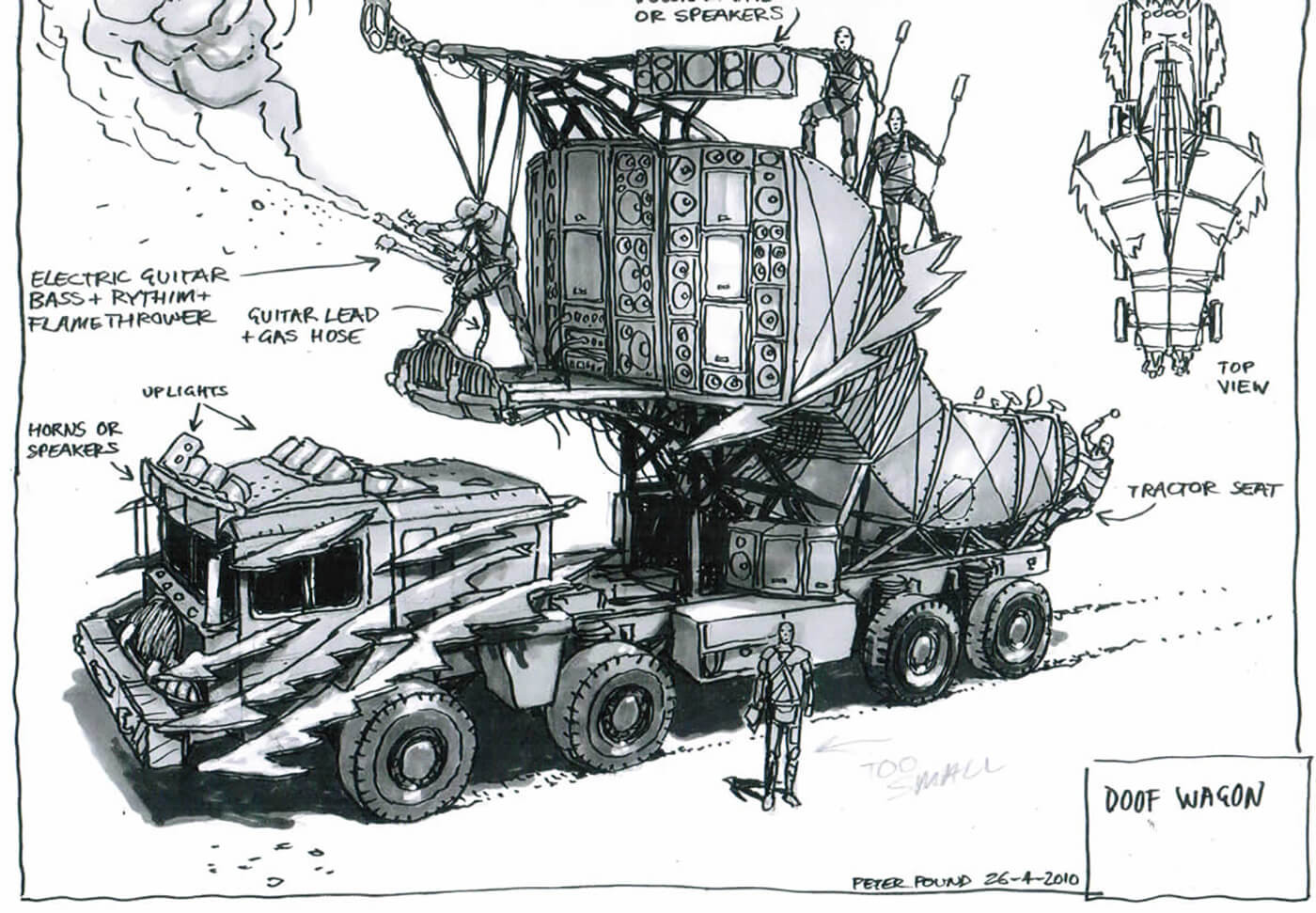 Peter Pound’s concept art, 2010
Peter Pound’s concept art, 2010
Original concept art by Peter Pound for the Doof Wagon and the Fury Road guitar, showcasing early design ideas.
For the guitar fury road‘s body, Ulman ingeniously used a bedpan, a darkly humorous choice that perfectly encapsulates the film’s twisted sensibility. He then populated this unconventional body with tuba valves, car horns, and a Zildjian cymbal, creating a chaotic yet strangely harmonious visual landscape. Even a motorcycle kickstand found new life as a whammy bar, injecting a touch of “speed shit” into the instrument’s functionality. A lattice-style metal skeleton provided the structural backbone, allowing Ulman to weld these disparate elements into a cohesive, albeit狂野 (wild), whole.
From Sculpture to Instrument: Matt Boug’s Engineering Challenge
Ulman’s creation was a stunning sculpture, but it wasn’t yet a functional instrument. That task fell to Matt Boug, an Australian industrial designer and propmaker. Boug’s challenge was to transform Ulman’s artistic vision into a playable, stage-ready guitar fury road that could withstand the rigors of filming in the desert. While Boug had a background around guitars, building one from scratch, especially one as unconventional as this, was uncharted territory. He briefly considered the DIY spirit of Brian May’s Red Special, but quickly realized the scale and complexity of the guitar fury road demanded a different approach.
 Ulman’s V1 guitar – notice that the strings aren’t yet connected
Ulman’s V1 guitar – notice that the strings aren’t yet connected
Michael Ulman’s initial V1 Fury Road guitar sculpture, highlighting the early stage of development before functional components were added.
Boug decided to treat the guitar fury road like a vehicle, focusing on structural integrity and functionality. Production designer Colin Gibson provided a double-neck guitar as a donor for parts, setting Boug on the path to making the guitar fury road sing – or rather, scream. Ulman’s original necks, deemed too short and non-functional, were replaced with the full-length necks from the donor guitar. Boug then engineered a chassis to fit within Ulman’s sculpture, providing a solid foundation to hold the necks and bridges in proper tension, ensuring playability.
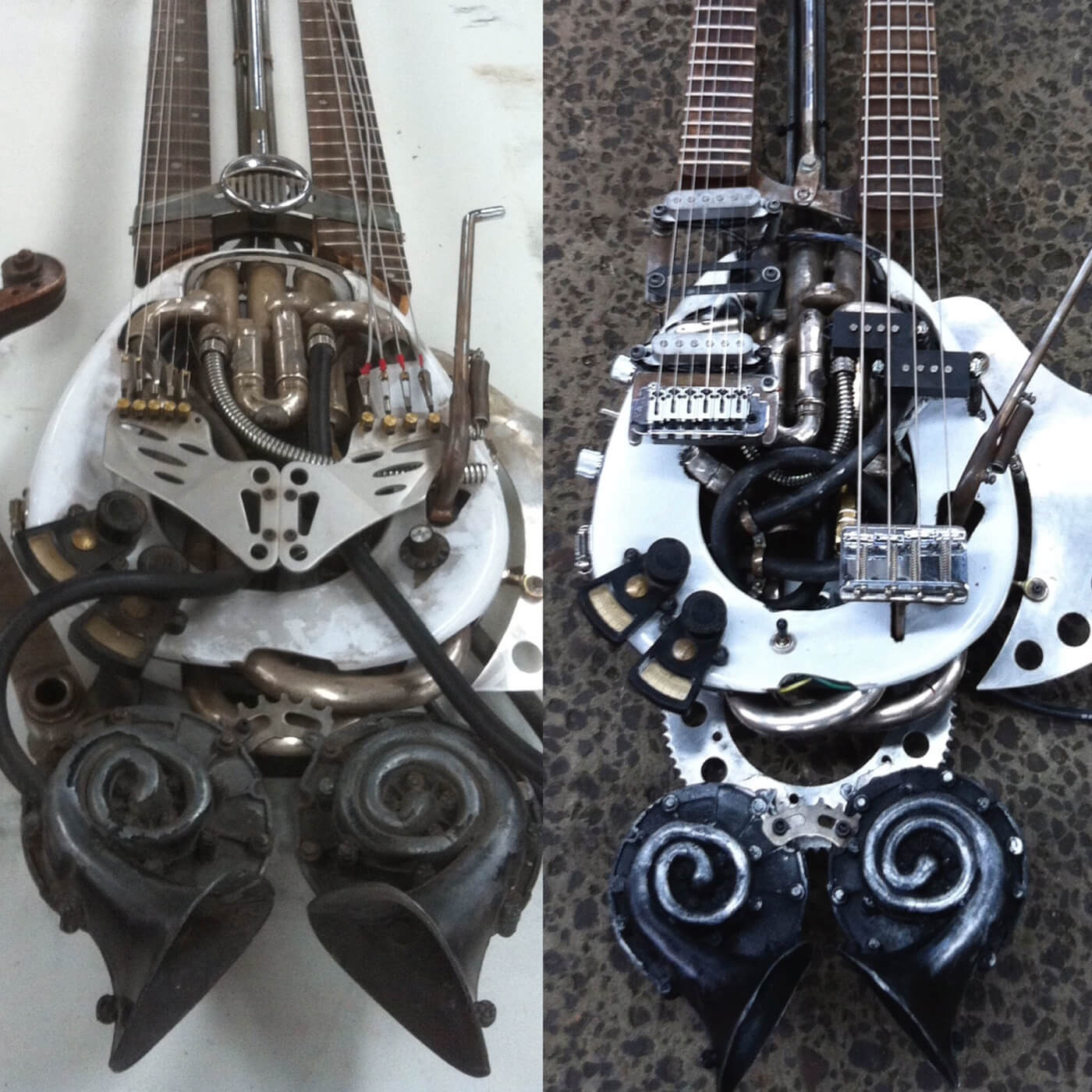 Side-by-side of Ulman’s V1 sculpture and the finished guitar
Side-by-side of Ulman’s V1 sculpture and the finished guitar
Comparison of Michael Ulman’s original Fury Road guitar sculpture and Matt Boug’s finalized, functional instrument.
Electrifying the Fury: Electronics and Flamethrower
With the structure sound, Boug turned his attention to electrifying the fury. Despite Boug’s desire for high-end components, budget constraints led to the use of pickups from the same donor double-neck, likely an Asian-made Fender copy. Integrating these electronics into the already crowded body of the guitar fury road was a painstaking process, requiring multiple disassemblies and reassemblies. The final setup included Strat-style single-coil guitar pickups, Precision-style bass pickups, volume and tone controls, and switches to toggle between guitar, bass, or both.
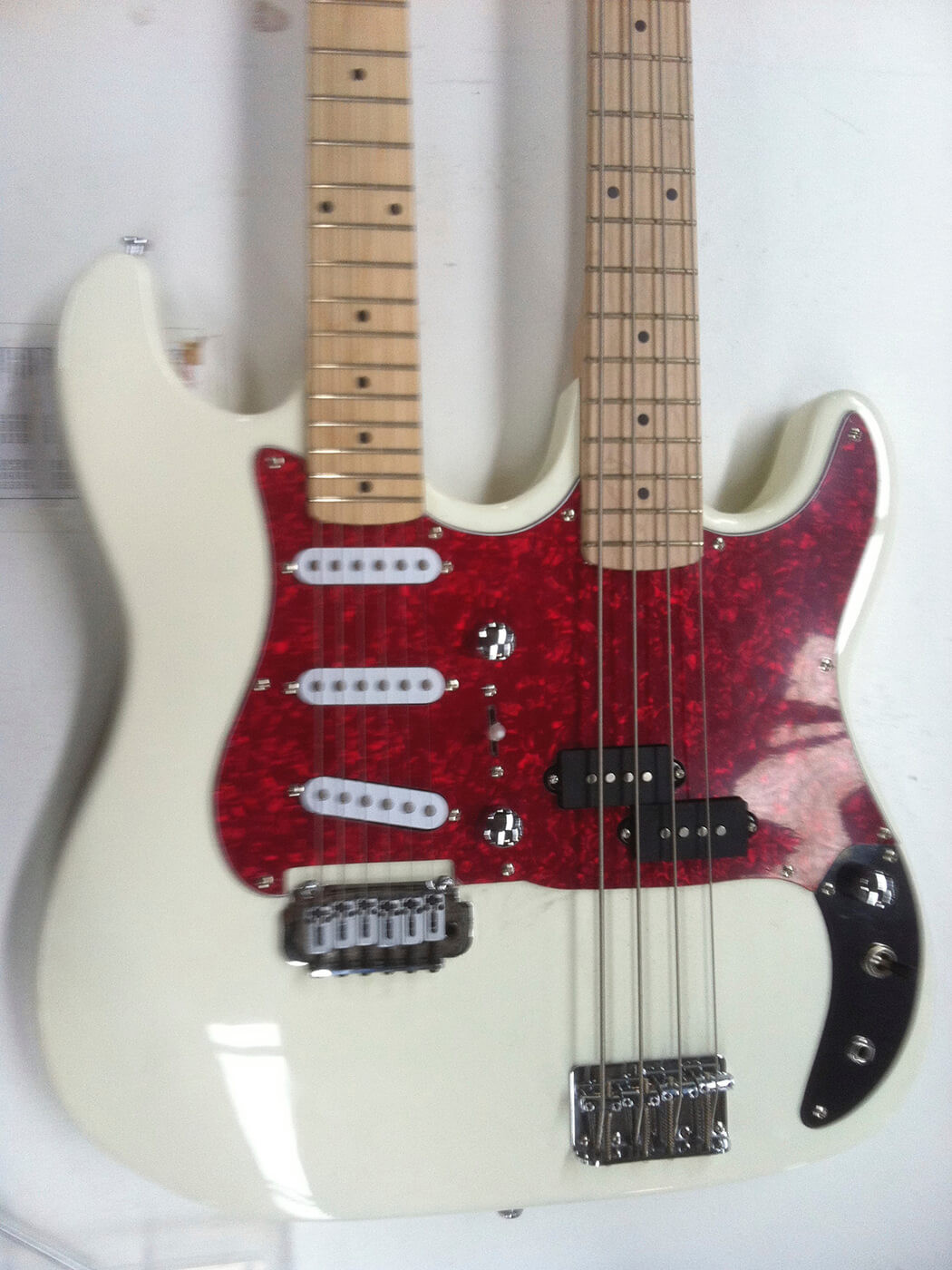 This Fender-style double-neck guitar/bass was cannibalised for parts
This Fender-style double-neck guitar/bass was cannibalised for parts
The Fender style double-neck guitar that was used as a source of parts for the functional Fury Road guitar.
Of course, no guitar fury road would be complete without its signature flamethrower. A fuel tube, running between the necks and controlled by the repurposed motorcycle kickstand whammy bar, was integrated to unleash 45-foot flames. To further enhance the post-apocalyptic aesthetic, Boug added a Datsun 1600 badge and used a blowtorch to char the necks, creating a “roasted maple” finish with a distinctly Mad Max twist.
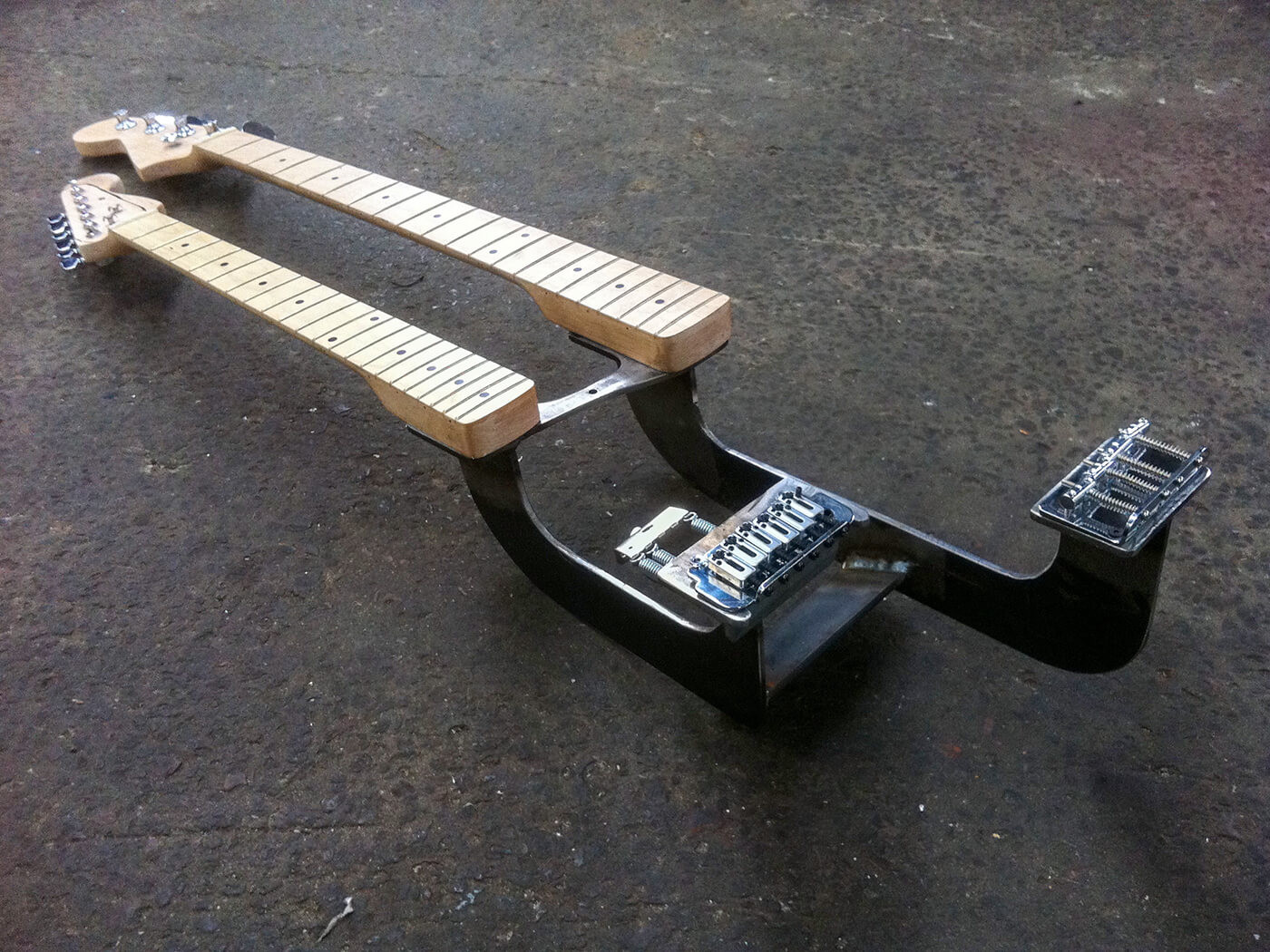 Boug’s DIY chassis would hold the necks and bridges in tension
Boug’s DIY chassis would hold the necks and bridges in tension
Matt Boug’s custom-built chassis designed to provide structural support and tension for the guitar necks and bridges.
iOTA: The Doof Warrior Unleashed
The guitar fury road was ready, but it needed a wielder, someone to embody the Doof Warrior‘s狂暴 (violent) energy. Enter iOTA, an Australian-Māori actor and musician known for his theatrical stage presence and rock-and-roll attitude. iOTA’s audition was less about technical guitar prowess and more about physicality. Clad in leather and wielding a Gibson SG, iOTA’s raw energy and stage-ready persona immediately captivated George Miller. He wasn’t hired to be a virtuoso, but to embody the狂野 (wild) spirit of the wasteland.
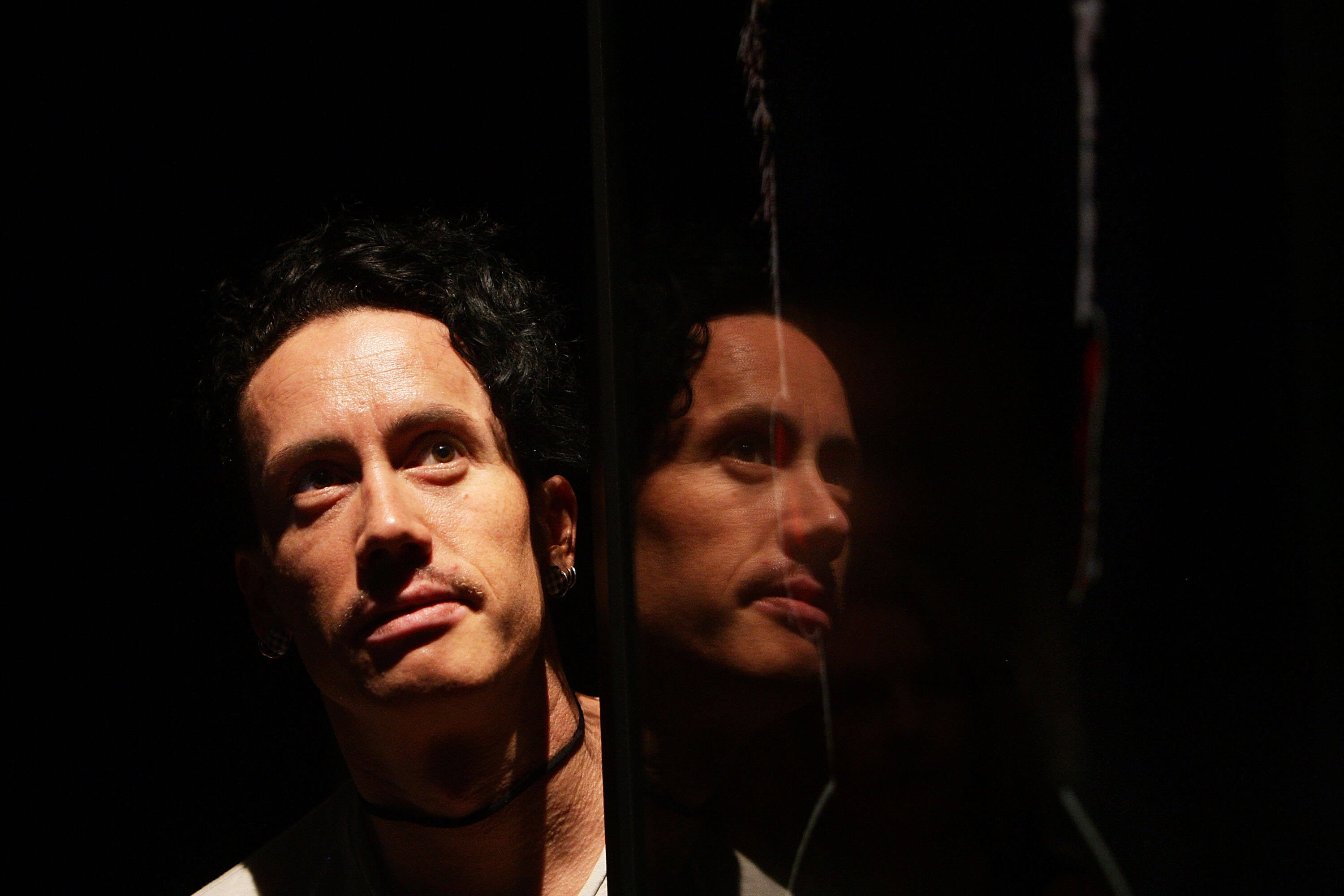 iOTA at the Sydney Theatre Company, 2012
iOTA at the Sydney Theatre Company, 2012
Actor and musician iOTA, who played the Doof Warrior, performing on stage prior to his role in Mad Max Fury Road.
Wielding the Weapon: Playing the Fury Road Guitar on Set
The reality of playing the guitar fury road on set was far from glamorous. Weighing a staggering 58 kilograms (128 lbs), the instrument was more weapon than guitar. To manage its immense weight, the production team devised a bungee cord suspension system, attaching the guitar fury road and iOTA to the Doof Wagon. This allowed iOTA to perform while suspended and moving, but it was a constant battle against gravity and momentum. iOTA embraced the challenge, focusing on raw, visceral sounds rather than intricate riffs. He even suggested adding a distortion pedal, a DigiTech Hardwire SC-2 Valve Distortion, to amplify the guitar fury road‘s sonic狂暴 (violence), creating a truly ear-splitting wall of noise.
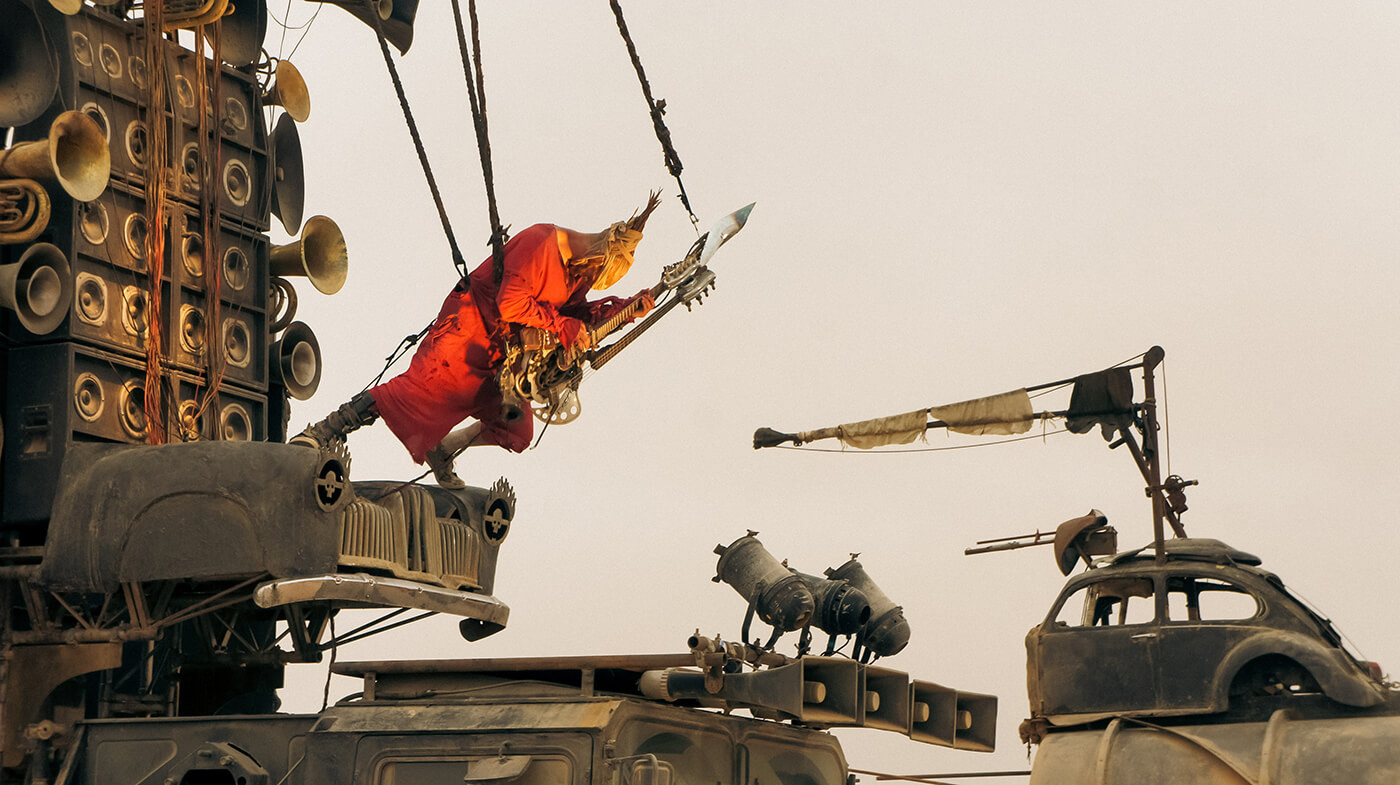 iOTA on set, strapped to the Doof Wagon, possibly napping
iOTA on set, strapped to the Doof Wagon, possibly napping
iOTA strapped to the Doof Wagon during filming, showcasing the challenging on-set conditions and guitar setup.
Sound of Fury: Junkie XL and the Film’s Score
Despite iOTA’s on-set performances, the final film’s score, including the guitar fury road‘s sonic identity, was crafted by composer Junkie XL (Tom Holkenborg). Inspired by stoner rock bands like Kyuss, Junkie XL used a Gibson SG and Les Paul tuned to CGCGBE, driving them through Fulltone pedals and an Orange Thunderverb amp. This setup created the film’s signature low-end rumble, mirroring the Doof Wagon‘s earth-shaking presence. While iOTA’s actual playing wasn’t featured, the spirit of his狂暴 (furious) performance and the iconic image of the guitar fury road were perfectly translated into Junkie XL’s powerful score.
 Boug testing the guitar
Boug testing the guitar
Matt Boug testing the functionality and playability of the Fury Road guitar before filming.
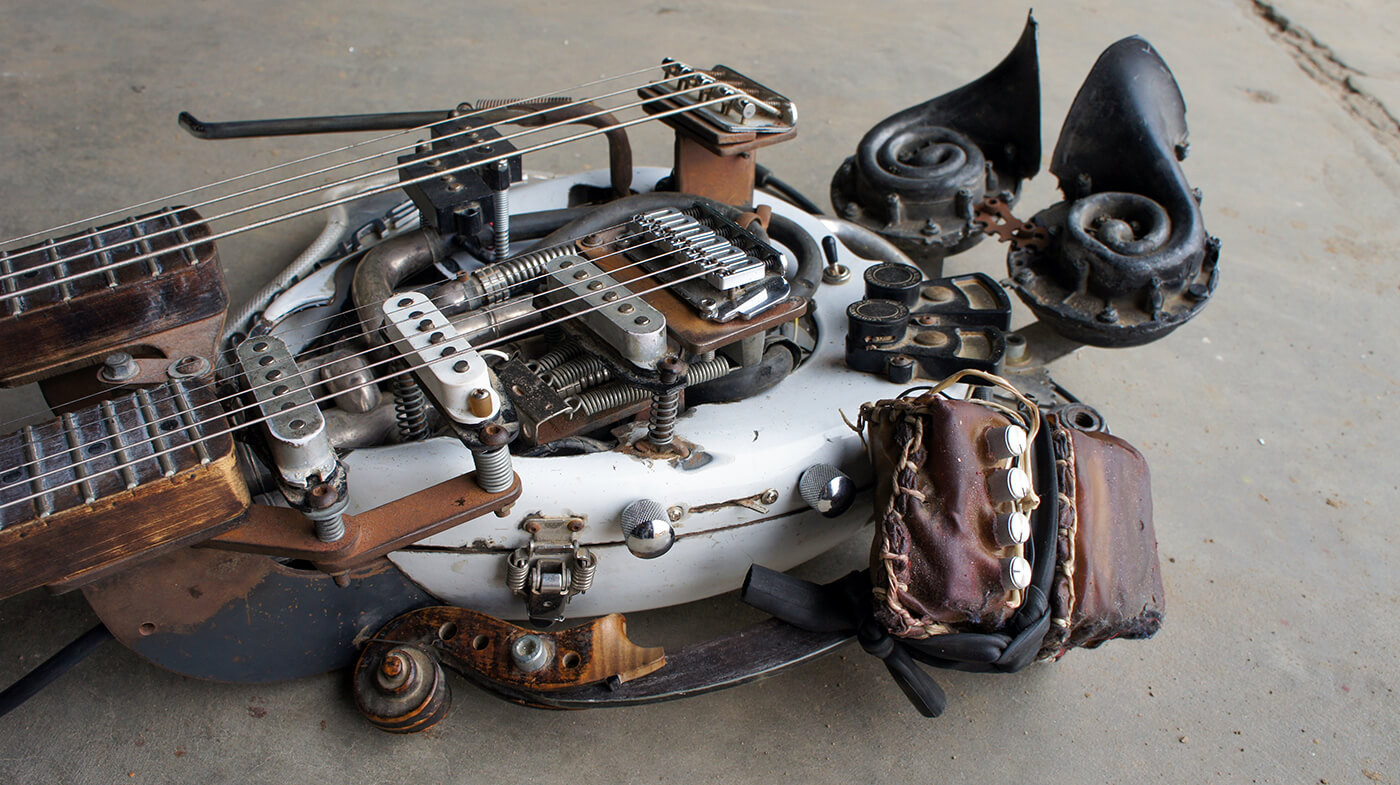 Close-up of the guitar’s construction, including pickups and distortion pedal
Close-up of the guitar’s construction, including pickups and distortion pedal
Detailed view of the Fury Road guitar’s components, including pickups, controls, and the DigiTech distortion pedal.
Legacy of the Fury Road Guitar: Beyond the Wasteland
The original guitar fury road survived the filming process and now resides in storage at Kennedy Miller Mitchell, a testament to its enduring iconic status. But its legacy extends far beyond the studio lot. Michael Ulman has created commissioned replicas, and countless fans have built their own versions, from scorching Epiphone Les Paul mods to flamethrowing ukuleles. The guitar fury road has been parodied on late-night TV and immortalized as a Funko Pop figurine, cementing its place in popular culture.
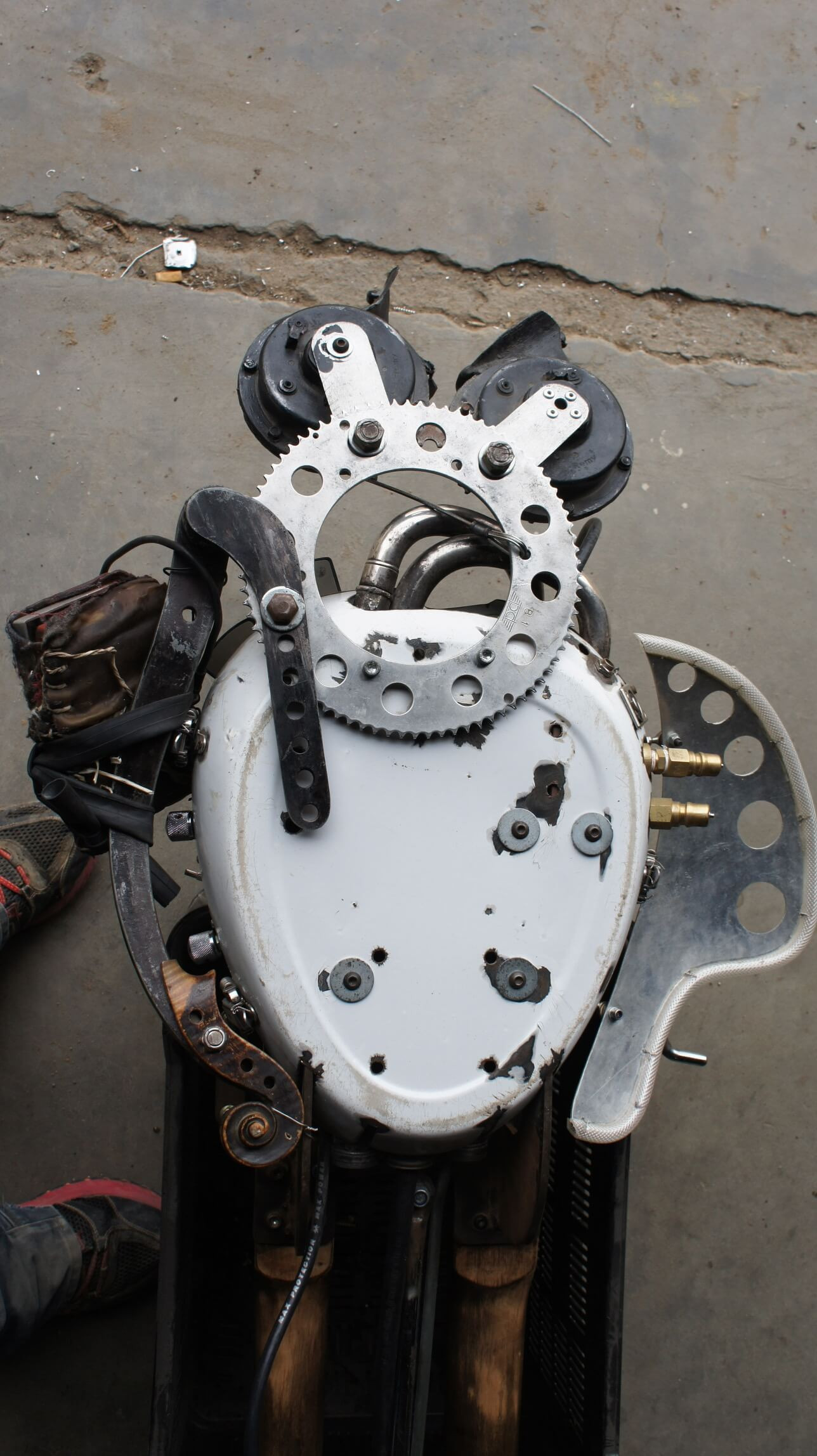 Rear of the guitar
Rear of the guitar
Rear view of the finished Fury Road guitar, highlighting the intricate details and construction.
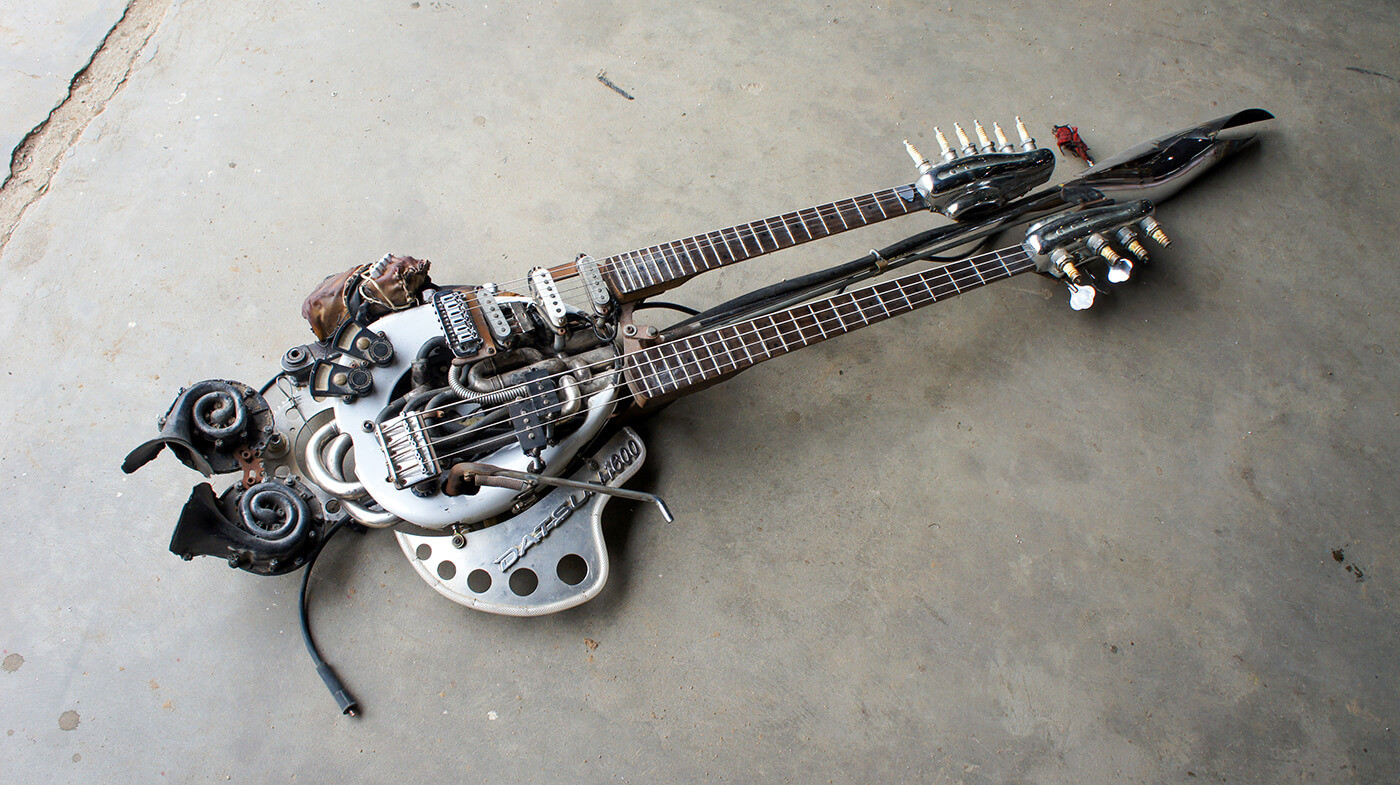 The finished Fury Road guitar
The finished Fury Road guitar
The completed and iconic Fury Road guitar as featured in Mad Max Fury Road, ready for its role in the film.
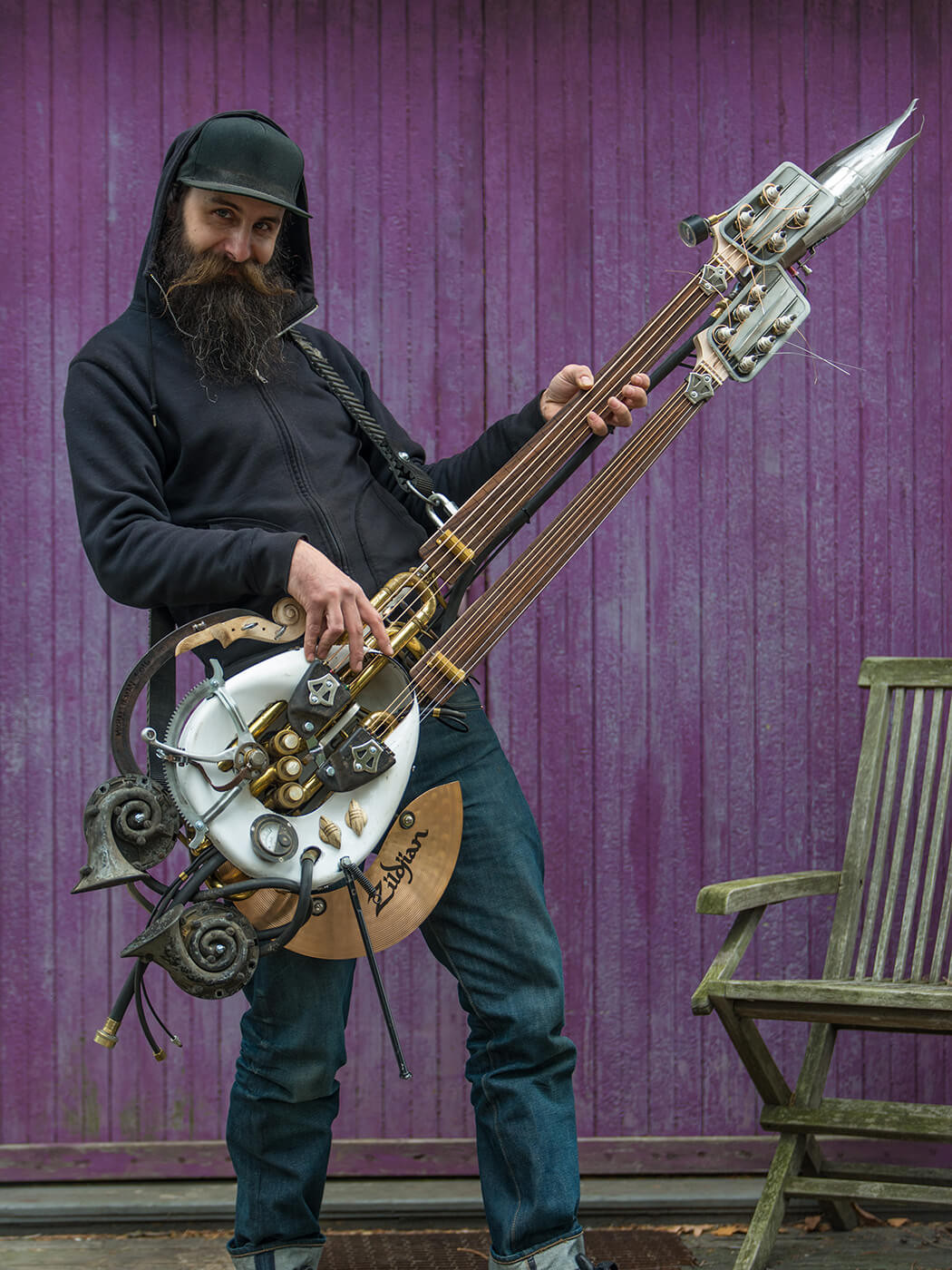 Ulman with one of his privately commissioned replica Fury Road guitars
Ulman with one of his privately commissioned replica Fury Road guitars
Michael Ulman with a replica Fury Road guitar he created after the film, demonstrating the enduring interest in the instrument.
The guitar fury road is more than just a movie prop; it’s a symbol of狂野 (wild) creativity, a fusion of art, engineering, and sheer cinematic madness. It’s a testament to the power of imagination and the enduring appeal of a film that turned twisted metal and guitar fury road into pure, unforgettable spectacle.
